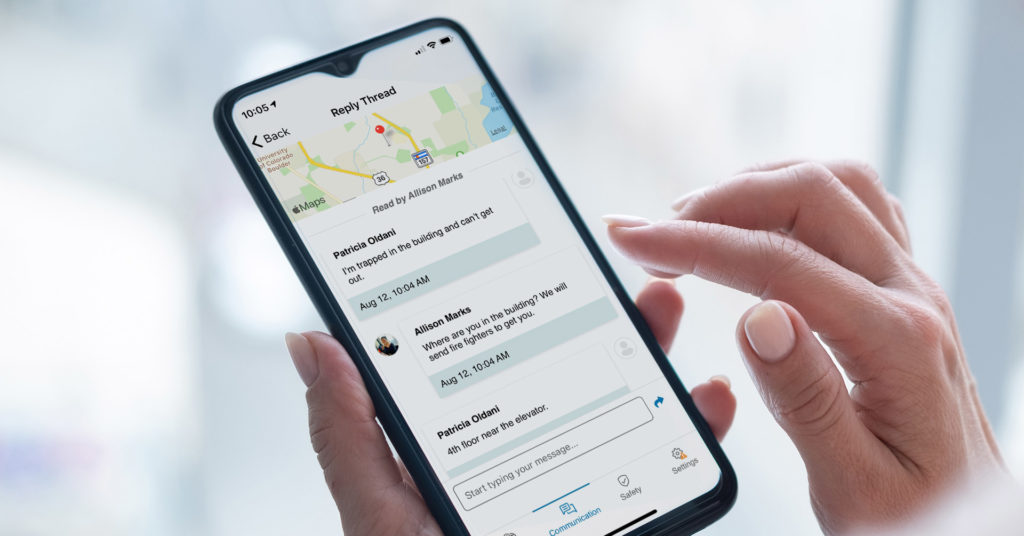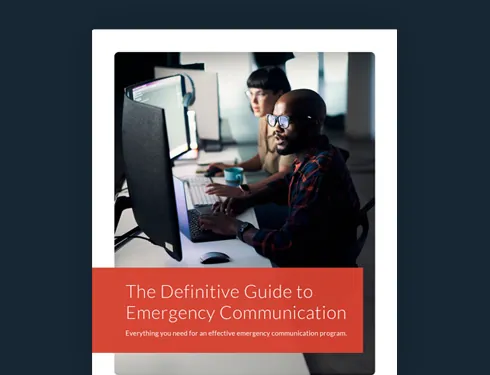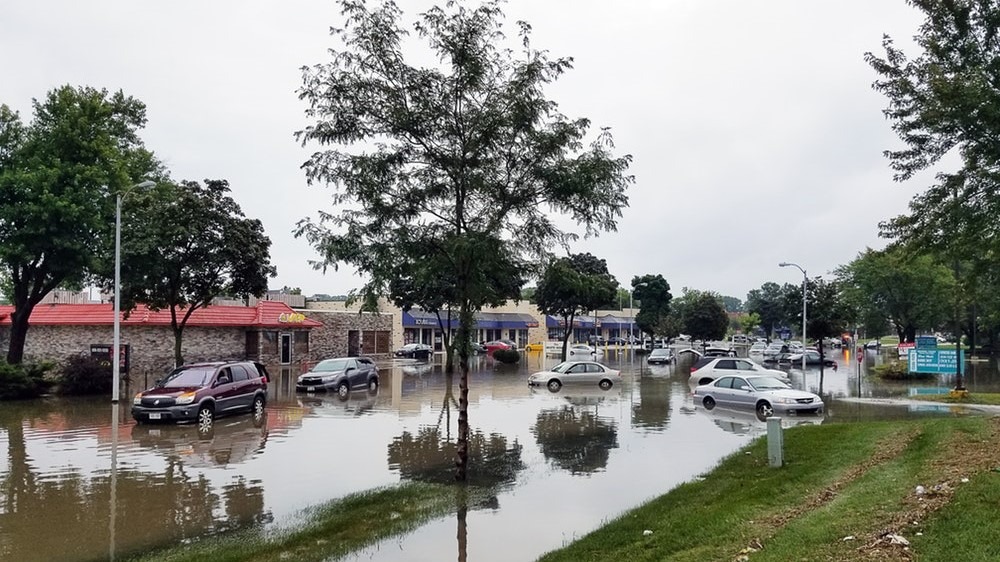
The Importance of Two-Way Communication During a Crisis
Being able to both send and receive information during an emergency is critical to keeping your teams safe. Learn about why two-way communications capabilities should be on your shortlist of ‘must-have’ features for any emergency notification solution.

Daniel works long hours as a truck driver for a logistics company. Roadblocks and unforeseen weather conditions can cause delays and sometimes even damage. After a few harrowing incidents, Daniel’s manager began manually sending out notifications via text message to keep drivers informed while on the road. But they soon learned this practice was flawed.
Why? There was no way for the company to receive information back from Daniel and the other drivers—or even know if they had received the company’s notifications at all.
There are workers everywhere who, like Daniel, are adversely affected by the lack of two-way communication channels at their organizations. Effective two-way communication has long been a challenge for many organizations—and that challenge has only been magnified by the impact of the COVID-19 pandemic. As businesses were quick to embrace remote working models over the last year, employees suddenly found themselves without the hallway conversations and water-cooler chats that often yield helpful information. At the same time, employees needed to stay in closer communication with their employers than ever before.
As a result, being able to communicate bi-directionally with employees during emergencies and critical events has increasingly become a top priority for organizations. Aptly put in this article by the CDC:
In this article, we’ll explore what effective two-way communication looks like, why it’s so important during emergencies, and business communication features to look for when evaluating emergency communication software.
What Is Two-Way Communication?
Simply put, two-way communication in a workplace is a conversation that involves two parties from the organization, both of whom can send and receive messages. Instead of one single communicator sending information into a black hole and hoping the intended recipient actually receives it, two-way communication enables the free flow of information. It allows organizations to have their finger on the pulse of the company and makes employees feel seen and heard.
A one-way communication process can bring up many problems for both parties involved. After all, listening is just as important—often even more important—than telling. When there is no feedback, there is no discussion that takes place, appropriate actions can’t be taken, and improvements can’t be made.
Just take a look at the stark differences between traditional forms of media—like TV and newspapers—and social media. While traditional media simply broadcasts information out without any feedback, social media enables real-time, two-way conversations. In fact, one of the key contributors to the rapid rise and popularization of social media is its ability to facilitate easy and effective two-way communication.
Ultimately, promoting and incorporating the practice of two-way communication into your company’s DNA will only lead to good—in daily meetings, internal events, and of course, emergencies. In emergency situations, for example, two-way communication enables the real-time exchange of information between those impacted by a critical event—and those that can help. Being able to send and receive critical news and knowledge about what’s going on means employees are never left to face a crisis on their own.
Common two-way communication channels
- Text message
- Phone call
- In-app/push notification
- Desktop alert
Why Is Two-Way Communication Important During an Emergency?
One-way communication methods offer a good start when it comes to coordinating an audience around an emergency or critical event. Unfortunately, they often leave safety leaders and managers feeling like they’re yelling into the abyss—and that’s the exact opposite of what you need when personal safety is at stake.
Here are four reasons two-way communication is critical during emergency situations:
1. Emergencies require confirmation
One-way communication essentially acts as a giant megaphone. It allows you to quickly disseminate information to your people—but it doesn’t allow you to hear responses, collect important data, or stay informed on the status of an ongoing event. And in an emergency situation—when seconds can mean the difference between a safe escape and a tragedy—that’s a big deal. Features such as two-way messaging and automated read receipts, you can easily see who has received your message—and who may need additional follow-up.
2. Emergencies create confusion
Emergency situations are often chaotic, and a lack of two-way communication only adds to the confusion. One-way alerts can cause inaccurate or unnecessary facts to spread by not allowing the audience to share feedback or ask questions. Like a giant game of telephone, information simply travels from place to place without allowing employees to provide information that may actually be important to recovering from an incident.
Let’s construct a scenario involving Lisa, a Customer Support Executive for an office supplies company. Lisa is working an evening shift at her office in San Diego. When a red flag warning is issued by the National Weather Service for San Jose—nearly 500 miles north of Lisa—an alert is mistakenly broadcast to all employees in California. Lisa and her colleagues are all left confused and grasping in the dark without a channel to get clarity from the HR team on which areas are in danger.
3. Not everyone experiences emergencies the same way
When emergencies occur, you need a way to prioritize your response and provide assistance to those that need it most. Following an earthquake or hurricane, for example, two-way communication allows you to determine who is safe and who is in need of immediate assistance.
Just take a look at multi-billion dollar construction firm, Moss Construction. With offices and construction sites across Hawaii, California, Texas, and Florida, Moss is no stranger to extreme weather. But when a Category 4 hurricane was slated to hit the Hawaiian Islands—a rare and potentially devastating event—Moss relied on two-way communication to ensure its people were ready.
A few hours before the hurricane was to hit, Moss sent a two-way survey notification to employees to confirm storm readiness. This allowed Moss to rapidly identify four employees that felt they were ill-prepared for the storm. Immediately, the organization was able to connect with and get these employees and their families to a safe location.
4. Emergencies are dynamic
In an emergency, the person initiating internal communication is often nowhere near where the event is taking place. A facilities or human resources leader working from the corporate office might be tasked with emergency communication—and that could be hundreds or even thousands of miles away from the event unfolding.
In order to take the appropriate actions, the communicator first needs to be able to find out what is happening on the ground to direct resources and coordinate response efforts with a common purpose in mind. In fact, it is the first-hand eyewitnesses that can often offer the most insight during rapidly evolving situations. In active shooter scenarios, for example, eyewitnesses are often able to provide information to authorities that can minimize the chance for injury and loss of life.
Bus transportation provider Greyhound also uses two-way emergency communication technology to communicate with its drivers and understand what is happening on the road. “Instead of having to track down a supervisor or call in to dispatch, drivers can send a quick text—even including a photo if they like—to notify or update us on an issue so they can get the help they need and move on with their day,” says Jennifer Saylor, Greyhound’s Manager of Customer Operations.
Types of Two-Way Communication Features
From natural disasters to IT system outages, the multitude of risks and threats businesses face is increasing every day. Your disaster response and recovery plan—as well as your emergency communication strategy—need to be built for the way people communicate today to ensure safety and mitigate business impact.
Two-way communication is more than a simple back-and-forth conversation between two individuals, such as through text message or email. A modern emergency communication solution should have robust two-way communication capabilities that include:
1. Read confirmations
During a time-sensitive event, recipients of an emergency alert may not be able to send back an elaborate written text or voice message acknowledging receipt or informing you of their status. Here, being able to confirm employees have seen and read a message can be invaluable. In the first example mentioned in this post involving Daniel, a truck driver, many of the company’s critical communication issues could be resolved by simply employing a solution that enables automated read receipts.
2. Wellness check surveys
Two-way communication systems with built-in survey functionality enable organizations to easily conduct employee wellness checks during critical events. During recent wildfires that threatened its community, for example, senior living community Paradise Valley Estates used two-way survey functionality to confirm resident well-being. Instantly, the organization was able to identify two dozen residents that needed help evacuating. “With these real-time insights, we were able to prioritize our efforts and send security up to those residents’ homes immediately to assist,” says Jeff Rausis, Director of Communications and IT at Paradise Valley Estates.
3. Event pages
Event pages are a powerful, real-time communication tool for administrators and employees to share pertinent information. Utilizing the event page functionality available within an emergency communication solution provides a single online repository for everything related to a specific event. Instead of employees calling or emailing for information, or worse, being left in the dark, they can continually visit the provided event page link, making it easier and more efficient for organizations to keep employees informed every step of the way.
4. Conference calls
If a critical matter comes up, meeting face-to-face isn’t an option, and you need to immediately collaborate with multiple stakeholders, sometimes there’s no substitute for a live call. Using an emergency communication solution with conference call functionality can help you quickly and reliably bridge a conference call. When downed power lines and a compromised electrical grid in the wake of Hurricane Harvey meant phone service was spotty, for example, the Gulf Coast Regional Blood Center used AlertMedia’s conference call functionality as its primary means of communication. The organization was able to instantly connect executives and directors to discuss emergency procedures and, ultimately, keep operations running.
Improving Safety With Effective Two-Way Communication
Two-way communication isn’t only about being aware of what is happening on the ground. It also helps you discern how you can best help those who may be in harm’s way. Perhaps the International Federation of Red Cross says it best: “Without listening we cannot hope to establish what support people need, and importantly what they do not need, or better ensure communities get the right help, in the right place, at the right time.”
Employee engagement and listening makes the entire emergency plan more precise, more flexible, and more successful. And by investing in a comprehensive emergency communication solution that enables real-time employee feedback, you will be able to respond more effectively during emergencies. A two-way emergency communication software like AlertMedia is a valuable tool for companies and a lifeline for employees during critical events, so you can keep your employees safe, informed, and connected when it matters most.

![11 Steps to Creating an Effective Emergency Response Plan [+ Template]](https://www.alertmedia.com/wp-content/uploads/2023/10/Blog-Emergency-Response-Plan.webp)


